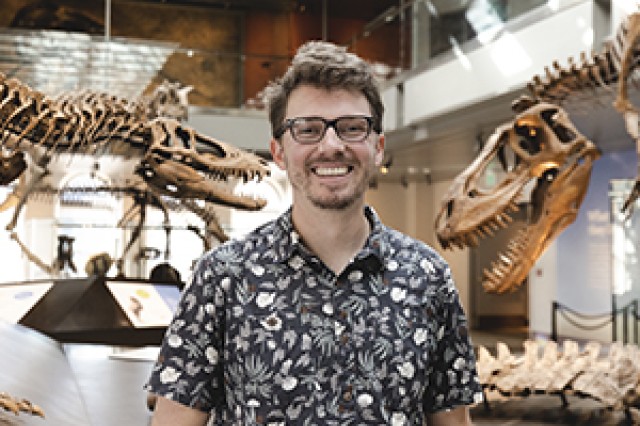
Dr. Hank Woolley
NSF Postdoctoral Research Scientist, Department of Biology, University of Washington 2023–2025 NSF Postdoctoral Fellow, Dinosaur Institute

The Postdoctoral program at NHMLAC supports the training of the next generation of museum scholars conducting original research across diverse disciplines. These Ph.D. researchers bring new perspectives to the museum and perform innovative studies that elevate our institutional reputation and often yield new discoveries, analytical tools, and even whole fields of research. Postdoctoral Fellows also contribute to the broader mission of the Museum through their collections, service, and outreach work.
NHMLAC Postdoctoral Fellows are exposed to unique museum programs and endeavors that are often not available in traditional university settings. These include experiences in museum collections management and curation, volunteer management, fundraising training, exhibit development and scientific communication, community science and engagement, and large-scale public festivals focused on informal science education. The cross-disciplinary nature of a museum, and a diverse Research & Collections group numbering over 100 staff, provide ample opportunity for Postdoctoral Fellows to build research relationships and perspectives spanning interests in e.g., earth history, biodiversity, climate science, history, and community science.
NHMLAC Postdoctoral Fellows are supported through a variety of means, including national fellowships, external grants, donor funds, and endowments. Our postdoctoral alumni have gone on to illustrious careers in prestigious academic, museum, and industry roles. Scholars interested in pursuing postdoctoral research at NHMLAC should review the resources below and reach out to the relevant Departments and Curators about opportunities.
Dr. Jenna McCullough (2025–2028)
NSF Postdoctoral Fellow, Ornithology
“The hidden role of structural white in the evolution of bird coloration”
Dr. Whitney Tsai Nakashima (2025–2028)
NSF Postdoctoral Fellow, Ornithology
“Understanding the past to conserve the future: integrating historical museum collections and avian conservation genomics”
WEBSITE
Dr. David Treviño Ledesma (2024–)
“Evolutionary history of herpetofauna on the Channel Islands: Using fossils to reconstruct the role of humans and the environment in driving evolution and influencing biodiversity”
Dr. Zachary Morris (2024–)
Dinosaur Institute Postdoctoral Fellow
“Integrating developmental, anatomical, and paleontological perspectives into the origins of convergence in the reptile skull”
Dr. Priscilla San Juan (2023–2025)
NSF-supported Postdoctoral Fellow, Mammalogy
“Evolutionary relationship between sucking lice and mammalian hosts”
Dr. Austin Baker (2022–2026)
California State Legislature-supported Postdoctoral Fellow, Entomology
“California insect barcode initiative: DNA barcoding all insect species of California”
Dr. Jose Alberto Cruz Silva (2023–2026)
NSF-supported Postdoctoral Fellow, Rancho La Brea
“Tropical ecosystem response to Late-Quaternary environmental change: Insight from remarkable asphalt-preserved biotas”
WEBSITE
Dr. Jackie Childers (2023–2026)
NSF Postdoctoral Fellow, Ornithology
“The evolution of an avian color palette: Understanding the roles of genes, environment, and life history underlying egg and feather color in weaver birds”
WEBSITE
Dr. Jessie George (2023–2026)
NHMLAC Postdoctoral Fellow, Rancho La Brea
“Phytolith reconstruction of vegetation in central Mexico during the Great American Biotic Interchange (GABI) and plant macrofossil and charcoal reconstruction of vegetation and fire at the La Brea Tar Pits during the Pleistocene”
Founded in 1913, the Natural History Museum of Los Angeles County represents one of the largest natural and cultural historical collections in the United States, caring for over 35 million specimens and objects spanning 4.5 billion years of earth history. It includes the main campus Natural History Museum in Exposition Park, as well as the La Brea Tar Pits in Hancock Park. NHMLAC also operates four off-site collection centers and facilities, totaling more than 100,000 square feet, housing especially extensive and/or large collections, ranging from invertebrate fossils and whale skeletons to historic automobiles. The museums serve over 1.3 million visitors a year, and include the only active urban paleontological excavation site in the world. The vision of NHMLAC is “To inspire wonder, discovery, and responsibility for our natural and cultural world”. Read more here.
NHMLAC employs a team of nearly 100 staff dedicated to the study and care of 18 collections and associated departments (each with associated equipment, libraries, and laboratory space) encompassing zoology, paleontology, geology, history, and anthropology. As part of the Research and Collections community, Postdoctoral Fellows have access to the vast analytical, laboratory, collections, and fieldwork resources of our institution. Postdoctoral Fellows also participate broadly in museum training opportunities. These include DEI workshops and training, community engagement sessions, and collections digitization working groups.
NHMLAC is also home to the Urban Nature Research Center (UNRC) and Diversity Initiative for the Southern California Ocean (DISCO) research institutes. Many research projects of UNRC and DISCO are supported by NHMLAC’s Community Science office, which coordinates community science and publicly engaged collaborative projects.
Read more about our:
Most of our Postdoctoral Fellows fall into one of three categories, although there may be exceptions: 1) Postdocs hired directly by NHM, e.g., on a grant to one of our curators, who are museum employees; 2) Postdocs with an independent grant such as an NSF Postdoctoral Fellowship, who are self-employed, not museum employees; 3) Postdocs working jointly with multiple mentors who are employed by another institution, but working on-site at the museum. Salaries and benefits such as healthcare coverage depend on these distinctions.
View NHM's career page
View important health plan information for NSF Postdoctoral Fellows hosted by NHMLAC who are not museum employees